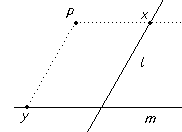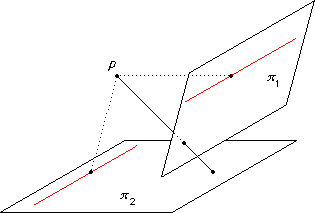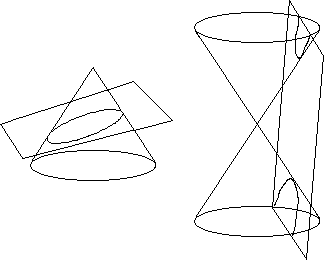 Unfortunately, this is not one-one. A line from P parallel to the line m does not meet m and so no point on m corresponds to the point x on l. Similarly no point on l corresponds to the point y on m.
Unfortunately, this is not one-one. A line from P parallel to the line m does not meet m and so no point on m corresponds to the point x on l. Similarly no point on l corresponds to the point y on m.
| Previous page (Similarity geometry) | Contents | Next page (Homogeneous coordinates) |
We now set up a geometry based on a space different from Rn.
Early Renaisance artists studied ideas of perspective. That is the problems of representing a three dimensional figure in a convincing way in two dimensions. These artists included Piero della Francesca (1412 to 1492) De prospectiva pingendi, Leone Alberti (1404 to 1472) Della pictura, Leonardo da Vinci (1452 to 1519) etc. Indeed the Greek Anaxagoras of Clazomenae (499BC to 428BC) may have written about perspective.
These ideas were developed into the notion of projective geometry which was studied in the 17th century by (among other) Girard Desargues (1591 to 1661).
We start with the correspondence between points on two lines given by projection from a point P not on either line.
 Unfortunately, this is not one-one. A line from P parallel to the line m does not meet m and so no point on m corresponds to the point x on l. Similarly no point on l corresponds to the point y on m.
Unfortunately, this is not one-one. A line from P parallel to the line m does not meet m and so no point on m corresponds to the point x on l. Similarly no point on l corresponds to the point y on m.
To remedy this we add a point at infinity to each line. Then x ↦ ∞m and y ↦ ∞l .
The space we get in this way consisting of the ordinary affine line R and this extra point is called the Real projective line and is written RP1.
 Similarly we set up a correspondence between the points of two planes π1 and π2 .
Similarly we set up a correspondence between the points of two planes π1 and π2 .
This time we add a line at infinity to each plane to make the correspondence into a bijection.
This gives us a space consisting of the ordinary affine plane R2 together with this extra (projective) line at infinity which is called the Real projective plane and is written RP2.
Remarks


| Previous page (Similarity geometry) | Contents | Next page (Homogeneous coordinates) |